The changing face of horse riding: Women in the saddle
Horse-riding, a passion of the rich and famous, is often perceived to be a male preserve. A few women are fighting to change the narrative
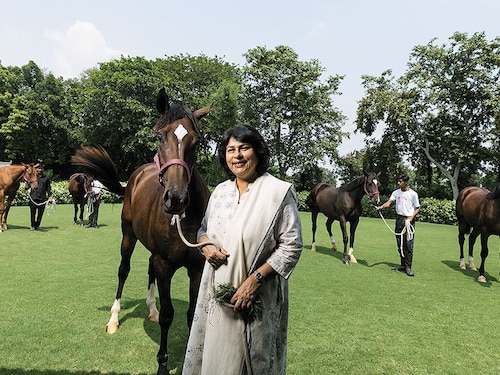

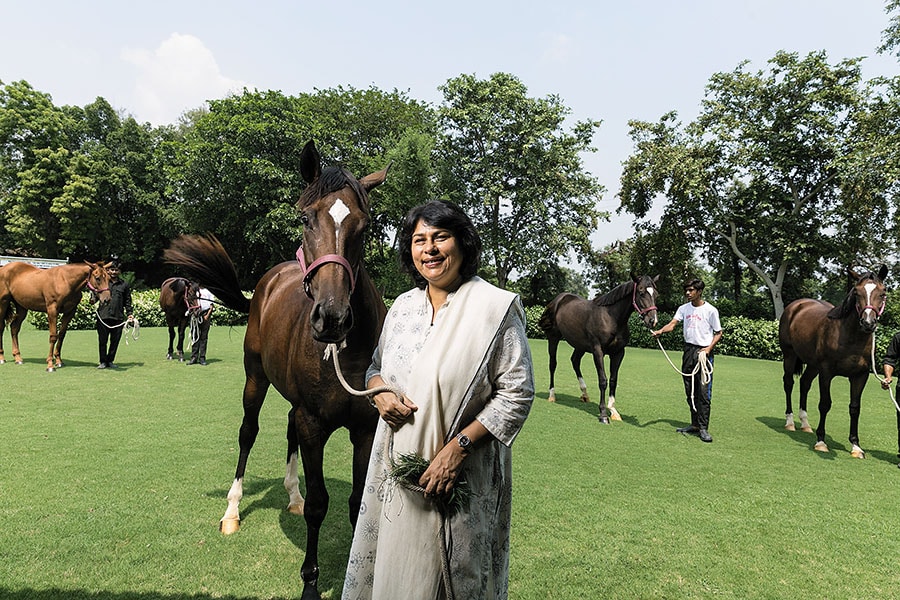 Ameeta Mehra’s Usha Stud Farms has bred 13 derby winners, the highest in the country ahead of 10 for Poonawalla Stud Farms
Ameeta Mehra’s Usha Stud Farms has bred 13 derby winners, the highest in the country ahead of 10 for Poonawalla Stud Farms
Image: Madhu Kapparath[br]It’s 9 on a Sunday morning and much of Pataudi, a town about 100 km from Delhi, is yawning off its sleepiness. At its solitary arterial road, most shops are shuttered, only a few hole-in-the-wall eateries have creaked open for breakfast. Revving Minidors at the town square are awaiting travellers to Gurugram, the nearest big city, but unlike the rush through the week, there’s only a trickle.
However, at the 120-acre Usha Stud Farms, located a few minutes down the Pataudi-Rewari road that branches out of the square, it’s business as usual. Around 10, Dhawaniyan, a dark bay yearling, troops into the round pen for training. Leading him into the arena is Parmeet Kaur, 33, dressed in denims and a striped T-shirt, her hands gripping the lunge reins. Dhawaniyan picks up his cue from Kaur’s cadence every time she sputters instructions, alternating between a walk and trot, or coming to a dead halt occasionally. Kaur may be all of 5’6’’ and Dhawaniyan a strapping 400-odd-kg, but there’s no mistaking who controls the reins.
It’s a rare sight, though, a woman holding mastery over the animal that has fuelled the passion of the rich and famous. For centuries, horse-riding in India has been considered to be elite—a preserve of the likes of billionaire businessmen like stud farm owner Cyrus Poonawalla or industrialist and polo aficionado Naveen Jindal—and masculine. Its gendered image has been buttressed by its association with an institution that is still debating the equality of roles for women—the army, whose 61st cavalry holds the distinction of being its only horsed cavalry unit and known for producing some of the finest equestrian sportsmen in the country.
Given its history, it’s evident why Kaur makes heads turn, and it’s one of the reasons she has been hired by Ameeta Mehra, of Usha Stud Farms, one of the few women in the male-dominated industry. “One of the things I have taken oath for is that if there are any women in my profession, I will back them. Women need to mentor other women for them to rise,” says Mehra.
It’s not an easy path, as Mehra would be the first to admit. Born to Major PK Mehra, she has been around horses since she was three, when she received a Shetland pony as a birthday gift. Since the early 90s, she had been part of her father’s equine business, living on a farm, working shoulder to shoulder with the boys and expanding operations through the decade. Mehra herself has bred seven Indian derby winners, out of a total 13 for the farm, the highest in the country ahead of 10 for Poonawalla Stud Farms. Yet, when she lost her parents and sister in a copter crash in 2001, everyone, her staff included, thought the farm would shut down. “I would meet my competitors who’d tell me ‘we’re sorry for your loss, of course you have to close down now’. My managers thought they needed to get new jobs, my vet went for another interview. Many of my male relatives also offered to step in,” she says. “But I refused. Two days after the accident, I was back at the farm.” 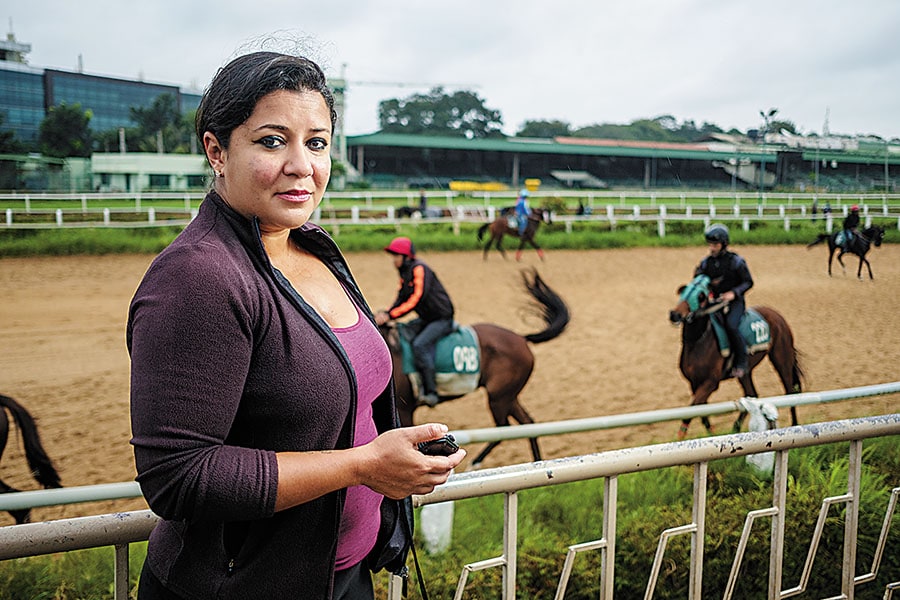 Parvati Byramji, south India’s first woman horse trainer
Parvati Byramji, south India’s first woman horse trainer
Image: Nishant Ratnakar for Forbes India[br]When Mehra started out, one could count the number of women dabbling in horses professionally. For every Arti Doctor, a horse trainer since 1988 in Mumbai and Kolkata, or a Silva Storai, an Italian who settled in India in the ’70s and got her jockey’s licence in 1992, there would be hordes of young girls who would ride for fun and then ditch it for a mainstream profession. Of the ones who stuck around, most would go for equestrian polo remained on the backseat for its inherent dangers and racing from its perception of being a gambling den.
Over the past decade, though, the tide seems to be turning. In 2013, for instance, Mumbai-based fashion designer Rinaa Shah became the country’s first woman to own a polo team in 2014, India sent its first all-women team for dressage—an Olympic equestrian discipline—at the Asian Games in Incheon, South Korea. In 2016, the first all-women’s polo team took part in the Tata Polo Cup in Delhi. The next year, Parvati Byramji, a bashful polo player from Mumbai’s Amateur Riders Club (ARC) in the mid-’90s, became South India’s first woman horse trainer.
Early in 2019, filmmaker Roopa Barua’s Daughters of the Polo God, a heart-warming story of Manipuri women making forays on the polo field, won the best documentary award at the 19th Annual New York Indian Film Festival, opening up gender conversations in the sport. Manipur, home to Sagol Kangjei, the ascendant of modern polo, now has about two dozen women players, many of whom teamed up for the first time in 2016 to play against American players in a tournament to celebrate its Statehood Day. 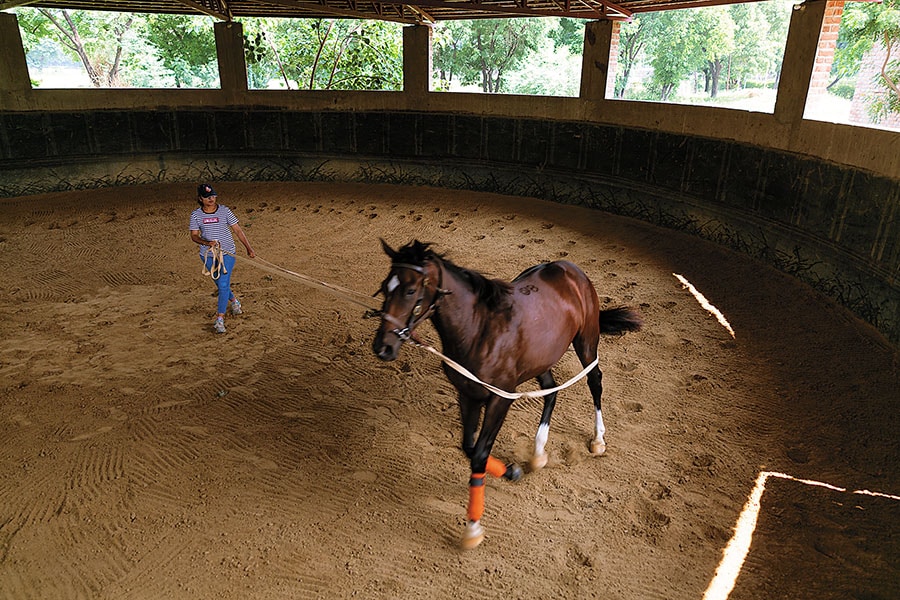 Parmeet Kaur trains a yearling at Usha Stud Farms
Parmeet Kaur trains a yearling at Usha Stud Farms
Image: Madhu Kapparath[br]But the most definitive proof of mainstreaming women in horse-riding came this August when a biopic, likely to star actor Taapsee Pannu, was announced on the life of Rupa Singh, the country’s first woman to become a jockey in 2002 Singh, 37, is now a trainer. Breaking the proverbial glass ceiling is still a far cry, but an army to chip at it is gradually coming together.
*****
The sport of equestrian, and more specifically of dressage, which tests a rider’s ability to make horses perform specific movements through subtle communication, has seen the largest cluster of women over the years. Major (Retd) JS Ahluwalia, an Arjuna awardee rider who has represented India in both the Olympics and the Asian Games, feels Indian women have been excelling in dressage over the last decade. Ahluwalia has been instrumental in the career of Vanita Malhotra, a former national champion, who was told after several years of riding that her basics were all wrong. Since 17, Malhotra has been under the tutelage of Ahluwalia and has been part of the first all-woman dressage team to the Asian Games in 2014. She was also part of the Jakarta contingent in 2018, before the Equestrian Federation of India (EFI) pulled the team out over qualification criteria.
But Indian girls have a tougher battle to fight than mere skills. “They have to fight societal bias. In Europe, girls grow up, get married and come back to the sport. In India, riding is never a sport well-acknowledged and lucrative enough for a girl to continue beyond schools or colleges,” says Ahluwalia.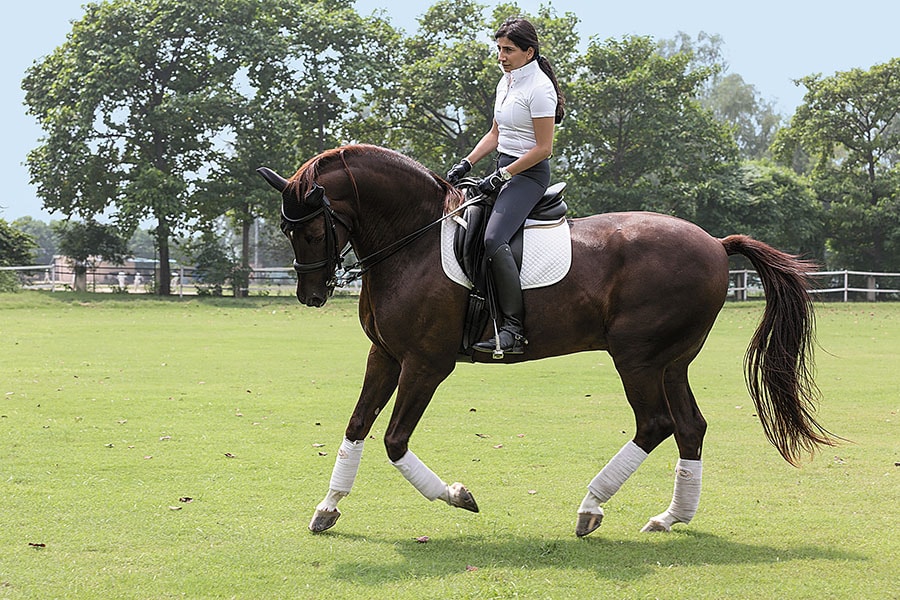 Vanita Malhotra represented India in the 2014 Asian Games as part of its first all-women contingent
Vanita Malhotra represented India in the 2014 Asian Games as part of its first all-women contingent
Image: Madhu Kapparath[br]Besides, the expenses of owning a horse make both equestrian and polo niche disciplines. A polo horse starts from anywhere between ₹3 lakh and ₹6 lakh. “A thoroughbred for showjumpers would cost you anything between ₹5 lakh and ₹15 lakh. A warmblood starts at ₹20 lakh. Besides, keeping a horse in prime condition would not come for anything less than ₹40,000 a month. That’s the EMI of a luxury car,” says Dipti Gohel, a marketing professional who took up riding at Mumbai’s ARC about six years ago.
An exception would be Ahluwalia’s current ward Shruti Vora, granddaughter of late industrialist KK Birla and a former national dressage champion who left the sport in 1997 when she got married. Vora returned to equestrian in 2009 to fill the void after both her grandparents passed away within months of each other in 2008. The 48-year-old is gunning for qualification in the 2020 Olympics by training in Germany’s Appelhulsen, away from her husband in Mumbai and two children at university in the US. “There are too many challenges in India in terms of infrastructure, coaches and the administrative mess that is the EFI. Twice, in 2010 and in 2018, our participation in the Asian Games was withheld at the last minute because of this. It deprives us of necessary international exposure. If I need to make a mark in global competitions, I have to train abroad, even if it means that January was the last time I could go home,” says Vora.
While the obstacles in equestrian are gender-neutral—in fact, the EFI insisted on equal gender representation while setting up an athlete’s commission in June headed by Malhotra—sports like polo and racing have set up formidable gender barriers for women for decades. Storai, now director of the Bengaluru-based Embassy Riding School and the only woman jockey in the world to win two derbies, sums it up in a sentence. “If I would win a race, it would be because the horse was good if I lost, it was because I wasn’t good enough.”Rinaa Shah (left) started playing polo at 38 and became the first woman to own a polo team in 2013[br]
Her words find resonance even now, in the experiences of Singh, the first Indian lady jockey, who would initially be given only mediocre horses to race. “Only when I started to win even with those horses did the trainers notice me. Even then, the external trainers gave me better horses, not the one who gave me my jockey’s licence,” says Singh. She won her first two races for external trainers and eventually went on to win 12 classics. In April, she acquired a trainer’s licence. But not much seems to have changed despite her track record. “I feel they don’t take me seriously yet. I’ve just been given 10 horses, the minimum one needs to start as a trainer. Hopefully, they’ll have confidence in me over time.”Byramji, who trains horses every morning at the Bangalore Turf Club, has also been called a “publicity stunt” or a front for her husband and celebrity trainer Darius. “A lot of men believe it’s him and not me. But I’d rather ignore them and look at incredibly supportive owners like Ameeta. That she sent one of her horses, Gift of Grace, to me to train, a horse bred at Usha, one of the best stud farms in the country, is a huge vote of confidence,” says Byramji.
*****
How does one extricate oneself from the gender stereotypes of horse-riding? With thick skin, of course, and a lot of pluck. Byramji recalls the years she was the only female polo player in the ARC and was taken lightly by her opponents. “At their own peril. I would take advantage of the fact that they were underestimating me and would hit the ball so hard that they wouldn’t make that mistake twice,” she says. Like, marking Colonel Ravi Rathore, an Arjuna Awardee, so hard that he yelled out to his teammates, “Get this girl off my back.” Or, jokes Byramji, when she was thrown out of the field for “cussing like a sailor”, just like the men.
Rinaa Shah, who now owns a polo team, took up the sport at 38, an age when most sportspersons retire. Hooked on to the game after one random visit to the Mahalaxmi Race Course in Mumbai, she started her training the next day, returning to the field despite two fractures in her thumb, back problems and stitches on her upper lip after being hit by a horse with his head. “It’s not an easy process. You have to train your hand with the stick, sit on a wooden horse and hit 100 balls every day, then gradually hit the field and pick up pace over the course of some time. Simultaneously, you’ve got to train the horse so that he isn’t scared of the stick, so that he knows he has to follow the ball,” says Shah.
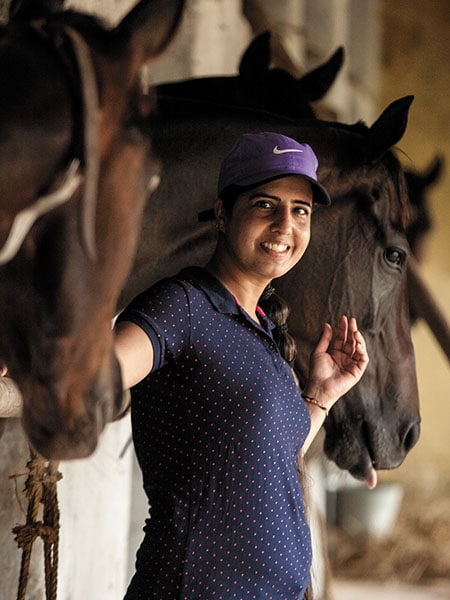 Rupa Singh, India’s first lady jockey and now the subject of a Bollywood biopic
Rupa Singh, India’s first lady jockey and now the subject of a Bollywood biopic
Image: P Ravikumar for Forbes India[br]The change in attitude doesn’t happen overnight, but builds up over time when one puts in the hard yards. At 61, Doctor, who chucked a career as an NID-trained graphic designer to become a horse-trainer, still wakes up at 4.30 am to reach the grounds, Shah spends three hours every morning to practise, and Vora isn’t looking to buy her tickets to Mumbai anytime soon. As Rupa Singh’s father would tell her, if men gave their 100 percent, she needed to give her 200 percent to move the needle, even when she was thrown off a horse galloping at 80 km per hour. Because riding a horse isn’t so much physical as it is technical.
“The strength of a man is his strength. And the strength of a woman is relating to a horse. She makes the horse want to do it for her without asking for it. It can be the difference between winning and losing a race,” says Storai.
Once Byramji proved her mettle on the polo field, her male colleagues rallied around her and even put their foot down when the National Defence Academy in Pune objected to a female member while hosting the ARC team for a match. “When they said there wouldn’t be an accommodation for me, all my male teammates huddled into a room and left the other room entirely for me,” she says. When the men would change into their jerseys in the middle of the field itself, they would form a phalanx outside her car to transform it into a changing room. Says Mehra, “Once you establish your credentials, and the excellence of your work, you rise in stature.”
Bottomline: You can’t leave out the men but fashion your own space along with them. On one side will be the men who would make the rules and push women aside, on the other will be those who egg them on. Like Singh’s father or Vora’s husband, who has happily granted her an indefinite leave of absence. Says filmmaker Barua, “When I named the film Daughters of the Polo God, I was told why are you putting a male perspective into it. But I do believe we cannot exist without our fathers, our brothers, our uncles, and there are enough men there who are promoting the women because they see the future in that.”
First Published: Oct 15, 2019, 18:02
Subscribe Now